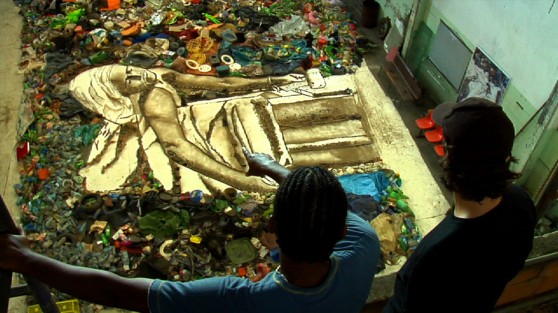Waste Land

Sarah 29, Death Race 27 (YEAH THAT’S RIGHT); 13 of 24 categories completed
Joe R put it best in a series of tweets last night after we’d seen it, so I’ll just quote him:
WASTE LAND (B): Acknowledges patronizing effect of making art out of poor people but maybe calling yourself out for that isn’t enough BUT…despite thinking garbage art is SO over, I gave in once I saw the art being created and the emotional weight it carries with the subjects[.] In summary, Rio is a WASTE LAND of contrasts. (Probably sits 4th out of the 4 Best Doc nominees I’ve seen, but it’s a crazy strong field.)
What I like best about Waste Land is the contrasts within the subjects, the recyclable-materials pickers of the largest landfill in Brazil (and possibly the world). Bunking in favelas, trying to see the positives in spending all day hip-deep in trash juice (“at least I’m not a hooker” is a note sounded frequently), they also have an edge to them; they snark. It defies the condescending “behold the dignity of the terribly poor” tone the movie tends to track back towards.
I also liked watching the art being built. I agree with Joe that found-objects art per se is a little sophomore-workshop, but the idea that, by asking the subjects to work on the construction of the portraits, the work then contains everyone who touched it — that’s very cool, and it’s clearly an experience of importance and power for the subjects. Vik Muniz is a bright guy who no doubt meant well — and did well — by the pickers, and it’s not Vik who patronizes them; the way he went about marrying art and community is admirable. The movie makes it feel somewhat pat, though, and I think showing us more of the physical, logistical process of putting together not just the portraits but the project as a whole might have de-saccharined the tone.
It’s a reasonably entertaining hour and a half that introduces you to some cool people, but it’s not going to punch its weight with the others in the category.
Tags: Joe R movies Oscars 2011 Death Race simmer down freshman Vik Muniz Waste Land





Ugh — I wanted to like this, and generally love Vik Muniz’s work, but in the end I *did* feel like he was patronizing the people there. Rather than actually allowing the pickers to participate in the art-making process, I wound up feeling like they were ultimately materials to him in the same way the garbage was. The scenes of him directing their every move, and essentially using them to do the labor while he stood from above and told them what to do / where to move… Just grated on me. I also didn’t understand why the film was structured the way it was — with Vik as the central character. I think if it had started with the pickers, and then introduced these filmmakers there at the dump, and then gradually revealed the project to the audience, bringing us up to the auction, and then finally to his donation of the proceeds, the whole thing would have felt much less like a ode to his do-goodieness.